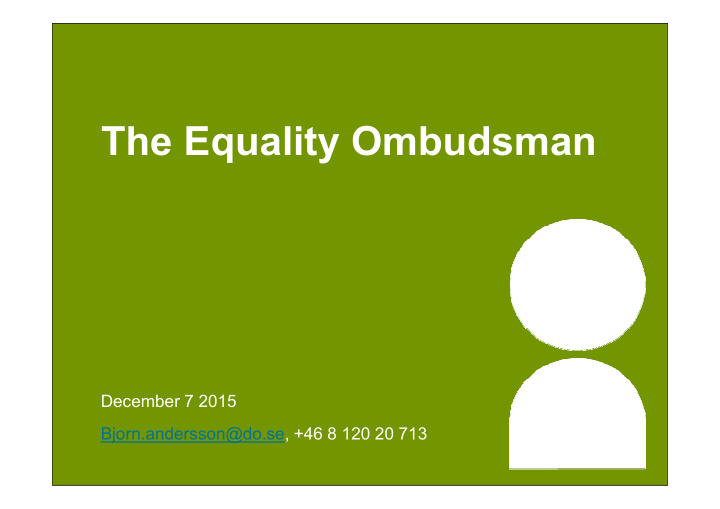



The Equality Ombudsman December 7 2015 Bjorn.andersson@do.se, +46 8 120 20 713
The Equality Ombudsman • Requirements by law • Evaluation of work demands • The gender pay gap December 7 2015 Bjorn.andersson@do.se, +46 8 120 20 713
The legal base for the work carried out by the Equality Ombudsman • Act concerning the Equality Ombudsman (2008:568) • Discrimination Act (2008:567) • Parental Leave Act (1995:584) Page 3
Important aspects of the discrimination act Chapter 2 Chapter 3 Chapter 4 Active measures Prohibition of to bring about Monitoring and discrimination equal rights and sanctions and reprisals opportunies Sida 4
Active measures • Active measures to bring about equal rights and opportunities in working life • Collective nature • Cooperation (3rd chapter, sections 1-2 §§) • Goal oriented (3rd chapter, section 3) • Detailed regulations (3rd chapter, sections 4-13 §§) Sida 5
The employer´s obligations Regulation about §§ DL Working conditions 3rd Chapter, sections 4-6 Recruitment 3rd Chapter, sections 7-9 Matters of pay , survey 3rd Chapter, section 10 Matters of pay , action plan 3rd Chapter, section 11 Matters of pay, duty to 3rd Chapter, section 12 inform Gender equality plan 3rd Chapter, section 13 Sida 6
Matters of pay • All employers are required to – Survey and analyse provisions and practices and pay differences – Cooperate with their employees • Employers with 25 or more employees are required to – Draw up an action play for equal pay • Every three years Sida 7
Section 10 In order to discover, remedy and prevent unfair gender differences in pay and other terms of employment, every three years the employer is to survey and analyse • provisions and practices regarding pay and other terms of employment that are used at the employer’s establishment, and • pay differences between women and men performing work that is to be regarded as equal or of equal value. The employer is to assess whether existing pay differences are directly or indirectly associated with sex. The assessment is to refer in particular to differences between • women and men performing work that is to be regarded as equal, and • groups of employees performing work that is or is generally considered to be dominated by women and groups of employees performing work that is to be regarded as of equal value to such work but is not or is not generally considered to be dominated by women. Sida 8
• Section 10 • Provisions and practices regarding pay and other terms of employment. – All relevant information – Kriterierna ska vara tydliga – Syftet är att samla den information som krävs för att genomföra det efterföljande arbetet. • Pay differences within equal work • Pay differences between groups performing work of equal value Sida 9
Section 11 Every three years employers are to draw up an action plan for equal pay in which they report the results of the survey and analysis described in Section 10. The plan is to indicate the pay adjustments and other measures that need to be taken to bring about equal pay for work that is to be regarded as equal or of equal value. The plan is to contain a cost estimate and a time plan based on the goal of implementing the necessary pay adjustments as soon as possible and within three years at the latest. A report on and evaluation of how the planned measures were implemented is to be included in the next action plan. The obligation to draw up an action plan for equal pay does not apply to employers who employed fewer than 25 employees at the start of the latest calendar year. Sida 10
• Section11 • pay adjustments and other measures • a cost estimate and a time plan • report on and evaluation of how the planned measures were implemented Sida 11
• Evaluation of work demands • Work is to be regarded as of equal value to other work if, on an overall assessment of the requirements and nature of the work, it can be deemed to be equal in value to the other work. The assessment of the requirements of the work is to take into account criteria such as knowledge and skills, responsibility and effort. In assessing the nature of the work, particular account is to be taken of working conditions. • Requirements, example: – Knowledge and skills – Responsibility – Effort and working conditions Sida 12
Edge/Lönevågen 5% BESTA 5% Analys Lönelots (DO) 6% N/A 30% Eget 14% övriga 18% BAS 22% Sida 13
• The survey and the pay gap • The survey is a method to discover differences in pay • Planned adjustments as a result of the survey in the actionplan • Sanctions Sida 14
Women’s pay as a percentage of men´s pay, taking into account differences in profession, sector, education, age and part-time employment 2005–2013. 2013 difference 2005–2012 Samtliga sektorer 94,2 1,0 Privat sektor 93,0 1,3 Arbetare 95,7 1,3 Tjänstemän 91,4 1,2 Offentlig sektor 97,0 0,5 Kommuner 99,4 0,3 Landsting 95,6 0,9 Staten 94,8 1,9 Source: SCB och Swedish National Mediation Office Sida 15
Gender pay gap 1974-2010 (timlön) (Boye et al. 2014), regressionsanalysis 40 35 30 Ojusterat 25 20 Justerat för arbetslivserfarenhet, senioritet och sektor 15 10 Justerat för arbetslivserfarenhet, senioritet, sektor och kvalifikationsnivå 5 0 1968 1974 1981 1991 2000 2010 source: Level-of-living survey (LNU) 1968, 1974, 1981, 1991, 2000 och 2010. Sida 16
?
Recommend
More recommend